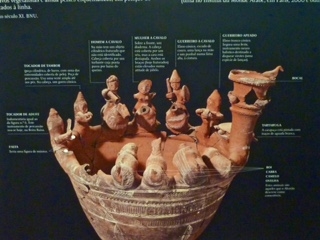Lynne Booker May 2012
The Islamic Centre of Tavira´s Municipal Museum has been fifteen years in gestation and was at last opened on 23 February 2012, in the presence of the Presidente da Câmara of Tavira, Jorge Botelho. He writes that the town has spent €2 million on the Centre, and has received relatively little financial support from the EU, and that the Centre will energise tourism and consolidate Tavira´s position as a regional and national reference point. Since Sr Botelho took over as Presidente in 2009, he has had to find a great deal of money out of diminishing receipts so that the Islamic Centre could be finished.

Last week, as Tavira ratepayers we visited our new Centre and were impressed by some aspects, and depressed by others. First the good news. The building and the general ambience of the display is modern and refreshing. The light wooden flooring and robust display cases containing fragments of pottery recovered by Tavira´s archaeologists are examples of the public architecture at which Portugal excels. The jewel of the display is the Tavira Vase which is highly visible in its presentation cabinet and is wonderfully described both on an accompanying board and by means of a video. The Tavira Vase is a find of international significance, and it is satisfying that such a piece has found its permanent place on display in its home town. The display board description of Tavira´s Moorish history makes for interesting reading, particularly since it is not well known, and it is possible to work out where the inhabitants of this Moorish fortified town lived in the 12th and 13th centuries until its reconquest by Christian forces in 1242.


When the former BNU building was first excavated, the archaeologists found that the Moorish wall of the castle formed an integral part of the building. And on display within the museum is a fragment of this wall, now encased in a cement coating. It is possible with some imagination to picture how the Moorish town was enclosed by this wall, which forms a continuation of the Moorish yellow ochre wall visible from the Praça da República.
So far so good. But the lettering of the displays is eyewateringly small and is only in Portuguese. There is no English description except in the subtitles of the film on a loop. Nor is there a catalogue of the displays to buy and take away for study at leisure. There is one catalogue, which is glued to a stand, but it is printed in Portuguese and Spanish only. On sale is a booklet of 2004, written and printed by the Mértola Archaeological Department, which describes the Tavira Vase in Portuguese. It was not designed to explain the context of the displays in this Centre. Those visitors to the Centre who are from a non-Portuguese speaking background will be frustrated by the lack of any information in English.
When the Posto de Turismo moved from its former site near the Misericórdia Church to its new site in the Praça da República opposite the Câmara, we thought that at last the Regional Tourism authorities and the Câmara were about to work together. But our visit to the new Centre has disillusioned us. The tourist information office occupies the ground floor of the same building as the new Centre, but there is apparently neither connexion nor cooperation between them. I for one do not understand why it is not possible in these times of financial austerity to operate this building as an entity.
To access the Centre itself, it is necessary to exit from the tourist office, go up through the Manueline gate, pass the Misericórdia, and enter the Centre through a back door on what is effectively the first floor of the same building. The Cente was staffed by a Câmara employee and I felt sorry for this charming man. Almost before we had spoken, he had apologised for the fact that there was no translation for the interested foreigner, and that there was no booklet or even a postcard which we could buy and take away with us. It is difficult to see how in its present form this Centre will energise tourism in Tavira. For me, it represents an opportunity missed.
